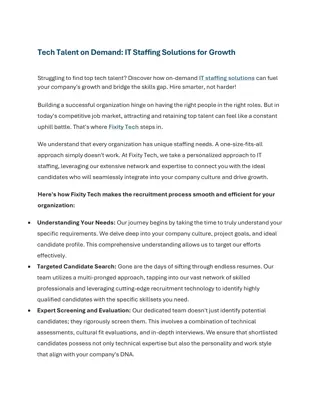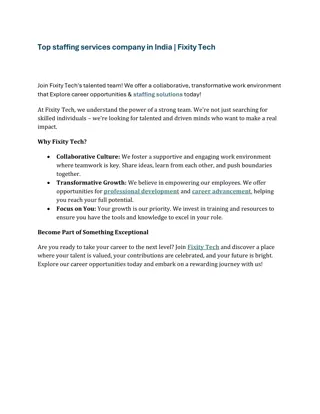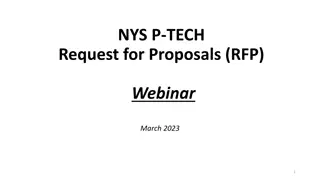
Effective Study Hints for Ham Radio Technician Class Exam Preparation
Enhance your chances of passing the Ham Radio Technician Class exam with effective study hints provided by Rich Bugarin. Learn key strategies such as reading questions and answers multiple times to improve your results. Gain valuable insights into station setup, power supply ratings, and more essential topics for success.
Download Presentation

Please find below an Image/Link to download the presentation.
The content on the website is provided AS IS for your information and personal use only. It may not be sold, licensed, or shared on other websites without obtaining consent from the author. If you encounter any issues during the download, it is possible that the publisher has removed the file from their server.
You are allowed to download the files provided on this website for personal or commercial use, subject to the condition that they are used lawfully. All files are the property of their respective owners.
The content on the website is provided AS IS for your information and personal use only. It may not be sold, licensed, or shared on other websites without obtaining consent from the author.
E N D
Presentation Transcript
Hi-Landers Ham Class Instructed by Rich Bugarin W6EC
Ham Radio Technician Class Exam preparation Power Point created by Rich Bugarin W6EC. Effective July 1, 2022 and is valid until June 30, 2026. Please send suggested changes to this presentation to: w6ec@thebugarins.com
Study Hints I suggest you read each question and only the correct answer. Read through the complete question pool at least three times before you attempt taking a practice exams. For higher impact and better results read the correct answer first then the question and again the correct answer. The key to passing the exam is to get the most questions correct using the above method the correct response will often jump out at you on test day even if you don t remember the question.
Text Color Black: Original/Official questions and information in original format (unaltered). Red: Original information text color simply changed to highlight subject. Blue: Notes and information added by Rich (W6EC).
SUBELEMENT T4 AMATEUR RADIO PRACTICES [2 Exam Questions - 2 Groups]
T4A Station setup: connecting a microphone, a power source, a computer, digital equipment, an SWR meter; bonding; Mobile radio installation #13 of 35
T4A01 Which of the following is an appropriate power supply rating for a typical 50 watt output mobile FM transceiver? A. 24.0 volts at 4 amperes B. 13.8 volts at 4 amperes C. 24.0 volts at 12 amperes D. 13.8 volts at 12 amperes
T4A01 Which of the following is an appropriate power supply rating for a typical 50 watt output mobile FM transceiver? A. 24.0 volts at 4 amperes B. 13.8 volts at 4 amperes C. 24.0 volts at 12 amperes D. 13.8 volts at 12 amperes Amps = Watts divided Volts. Here 50 watts needs about 5 amps @ 12V The power supply needs to be bigger than minimum required.
T4A02 Which of the following should be considered when selecting an accessory SWR meter? A. The frequency and power level at which the measurements will be made B. The distance that the meter will be located from the antenna C. The types of modulation being used at the station D. All these choices are correct
T4A02 Which of the following should be considered when selecting an accessory SWR meter? A. The frequency and power level at which the measurements will be made B. The distance that the meter will be located from the antenna C. The types of modulation being used at the station D. All these choices are correct
T4A03 Why are short, heavy-gauge wires used for a transceiver s DC power connection? A. To minimize voltage drop when transmitting B. To provide a good counterpoise for the antenna C. To avoid RF interference D. All these choices are correct
T4A03 Why are short, heavy-gauge wires used for a transceiver s DC power connection? A. To minimize voltage drop when transmitting B. To provide a good counterpoise for the antenna C. To avoid RF interference D. All these choices are correct
T4A04 How are the transceiver audio input and output connected in a station configured to operate using FT8? A. To a computer running a terminal program and connected to a terminal node controller unit B. To the audio input and output of a computer running WSJT-X software C. To an FT8 conversion unit, a keyboard, and a computer monitor D. To a computer connected to the FT8converter.com website
T4A04 How are the transceiver audio input and output connected in a station configured to operate using FT8? A. To a computer running a terminal program and connected to a terminal node controller unit B. To the audio input and output of a computer running WSJT-X software C. To an FT8 conversion unit, a keyboard, and a computer monitor D. To a computer connected to the FT8converter.com website (See next slide)
What is FT8? FT8 is one of the many digital modes often referred to as sound card modes (SCM) because they utilize a computer s sound card to bring in audio from your radio to be processed by software to decode the information embedded in the signal. Conversely, when you want to transmit, the software encodes your message into audio tones that are sent out via your sound card to your radio s audio or Mic input. Screen shot of WSJT-X software
T4A05 Where should an RF power meter be installed? A. In the feed line, between the transmitter and antenna B. At the power supply output C. In parallel with the push-to-talk line and the antenna D. In the power supply cable, as close as possible to the radio
T4A05 Where should an RF power meter be installed? A. In the feed line, between the transmitter and antenna B. At the power supply output C. In parallel with the push-to-talk line and the antenna D. In the power supply cable, as close as possible to the radio
T4A06 What signals are used in a computer-radio interface for digital mode operation? A. Receive and transmit mode, status, and location B. Antenna and RF power C. Receive audio, transmit audio, and transmitter keying D. NMEA GPS location and DC power
T4A06 What signals are used in a computer-radio interface for digital mode operation? A. Receive and transmit mode, status, and location B. Antenna and RF power C. Receive audio, transmit audio, and transmitter keying D. NMEA GPS location and DC power
T4A07 Which of the following connections is made between a computer and a transceiver to use computer software when operating digital modes? A. Computer line out to transceiver push-to-talk B. Computer line in to transceiver push-to-talk C. Computer line in to transceiver speaker connector D. Computer line out to transceiver speaker connector
T4A07 Which of the following connections is made between a computer and a transceiver to use computer software when operating digital modes? A. Computer line out to transceiver push-to-talk B. Computer line in to transceiver push-to-talk C. Computer line in to transceiver speaker connector (Speaker out) D. Computer line out to transceiver speaker connector
T4A08 Which of the following conductors is preferred for bonding at RF? A. Copper braid removed from coaxial cable B. Steel wire C. Twisted-pair cable D. Flat copper strap
T4A08 Which of the following conductors is preferred for bonding at RF? A. Copper braid removed from coaxial cable B. Steel wire C. Twisted-pair cable D. Flat copper strap Bonding is AKA Grounding
T4A09 How can you determine the length of time that equipment can be powered from a battery? A. Divide the watt-hour rating of the battery by the peak power consumption of the equipment B. Divide the battery ampere-hour rating by the average current draw of the equipment C. Multiply the watts per hour consumed by the equipment by the battery power rating D. Multiply the square of the current rating of the battery by the input resistance of the equipment
T4A09 How can you determine the length of time that equipment can be powered from a battery? A. Divide the watt-hour rating of the battery by the peak power consumption of the equipment B. Divide the battery ampere-hour rating by the average current draw of the equipment C. Multiply the watts per hour consumed by the equipment by the battery power rating D. Multiply the square of the current rating of the battery by the input resistance of the equipment
T4A10 What function is performed with a transceiver and a digital mode hot spot? A. Communication using digital voice or data systems via the internet B. FT8 digital communications via AFSK C. RTTY encoding and decoding without a computer D. High-speed digital communications for meteor scatter
T4A10 What function is performed with a transceiver and a digital mode hot spot? A. Communication using digital voice or data systems via the internet B. FT8 digital communications via AFSK C. RTTY encoding and decoding without a computer D. High-speed digital communications for meteor scatter
T4A11 Where should the negative power return of a mobile transceiver be connected in a vehicle? A. At the 12 volt battery chassis ground B. At the antenna mount C. To any metal part of the vehicle D. Through the transceiver s mounting bracket
T4A11 Where should the negative power return of a mobile transceiver be connected in a vehicle? A. At the 12 volt battery chassis ground B. At the antenna mount C. To any metal part of the vehicle D. Through the transceiver s mounting bracket
T4A12 What is an electronic keyer? A. A device for switching antennas from transmit to receive B. A device for voice activated switching from receive to transmit C. A device that assists in manual sending of Morse code D. An interlock to prevent unauthorized use of a radio
T4A12 What is an electronic keyer? A. A device for switching antennas from transmit to receive B. A device for voice activated switching from receive to transmit C. A device that assists in manual sending of Morse code D. An interlock to prevent unauthorized use of a radio
T4B - Operating controls: frequency tuning, use of filters, squelch function, AGC, memory channels, noise blanker, microphone gain, receiver incremental tuning (RIT), bandwidth selection, digital transceiver configuration #14 of 35
T4B01 What is the effect of excessive microphone gain on SSB transmissions? A. Frequency instability B. Distorted transmitted audio C. Increased SWR D. All these choices are correct
T4B01 What is the effect of excessive microphone gain on SSB transmissions? A. Frequency instability B. Distorted transmitted audio C. Increased SWR D. All these choices are correct
T4B02 Which of the following can be used to enter a transceiver s operating frequency? A. The keypad or VFO knob B. The CTCSS or DTMF encoder C. The Automatic Frequency Control D. All these choices are correct
T4B02 Which of the following can be used to enter a transceiver s operating frequency? A. The keypad or VFO knob B. The CTCSS or DTMF encoder C. The Automatic Frequency Control D. All these choices are correct VFO = Variable Frequency Oscillator (or Operation) named for the circuit that tunes the radio to different frequencies.
T4B03 How is squelch adjusted so that a weak FM signal can be heard? A. Set the squelch threshold so that receiver output audio is on all the time B. Turn up the audio level until it overcomes the squelch threshold C. Turn on the anti-squelch function D. Enable squelch enhancement
T4B03 How is squelch adjusted so that a weak FM signal can be heard? A. Set the squelch threshold so that receiver output audio is on all the time B. Turn up the audio level until it overcomes the squelch threshold C. Turn on the anti-squelch function D. Enable squelch enhancement Squelch is the circuit that quiets (Hides) background noise
T4B04 What is a way to enable quick access to a favorite frequency or channel on your transceiver? A. Enable the frequency offset B. Store it in a memory channel C. Enable the VOX D. Use the scan mode to select the desired frequency
T4B04 What is a way to enable quick access to a favorite frequency or channel on your transceiver? A. Enable the frequency offset B. Store it in a memory channel C. Enable the VOX D. Use the scan mode to select the desired frequency
T4B05 What does the scanning function of an FM transceiver do? A. Checks incoming signal deviation B. Prevents interference to nearby repeaters C. Tunes through a range of frequencies to check for activity D. Checks for messages left on a digital bulletin board
T4B05 What does the scanning function of an FM transceiver do? A. Checks incoming signal deviation B. Prevents interference to nearby repeaters C. Tunes through a range of frequencies to check for activity D. Checks for messages left on a digital bulletin board
T4B06 Which of the following controls could be used if the voice pitch of a single-sideband signal returning to your CQ call seems too high or low? A. The AGC or limiter B. The bandwidth selection C. The tone squelch D. The RIT or Clarifier
T4B06 Which of the following controls could be used if the voice pitch of a single-sideband signal returning to your CQ call seems too high or low? A. The AGC or limiter B. The bandwidth selection C. The tone squelch D. The RIT or Clarifier Incremental Tuning (Receive Fine Tuning) RIT = Receive
T4B07 What does a DMR code plug contain? A. Your call sign in CW for automatic identification B. Access information for repeaters and talkgroups C. The codec for digitizing audio D. The DMR software version
T4B07 What does a DMR code plug contain? A. Your call sign in CW for automatic identification B. Access information for repeaters and talkgroups C. The codec for digitizing audio D. The DMR software version A Code Plug is a fancy name for the software file (program) that downloads data into your radio to tell it what to do.
T4B08 What is the advantage of having multiple receive bandwidth choices on a multimode transceiver? A. Permits monitoring several modes at once by selecting a separate filter for each mode B. Permits noise or interference reduction by selecting a bandwidth matching the mode C. Increases the number of frequencies that can be stored in memory D. Increases the amount of offset between receive and transmit frequencies
T4B08 What is the advantage of having multiple receive bandwidth choices on a multimode transceiver? A. Permits monitoring several modes at once by selecting a separate filter for each mode B. Permits noise or interference reduction by selecting a bandwidth matching the mode C. Increases the number of frequencies that can be stored in memory D. Increases the amount of offset between receive and transmit frequencies (See next slide)
Bandwidth In electronics is the range of frequencies occupied by a modulated radio-frequency signal, usually given in hertz (cycles per second) For example, an AM station operating at 1,000,000 hertz has a bandwidth of 10,000 hertz, or 1 percent. The term also designates the frequency range that an electronic device, such as an amplifier or filter, will transmit VHF (2 Meter) Typically uses Wide Band Width @ 25 MHz spacing but Narrow Band Width @ 12.5 MHz spacing is available on newer radios.






















